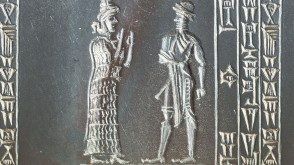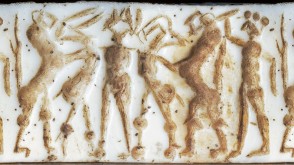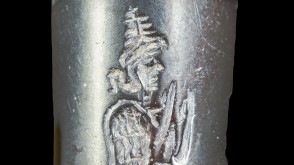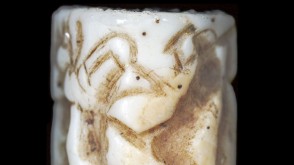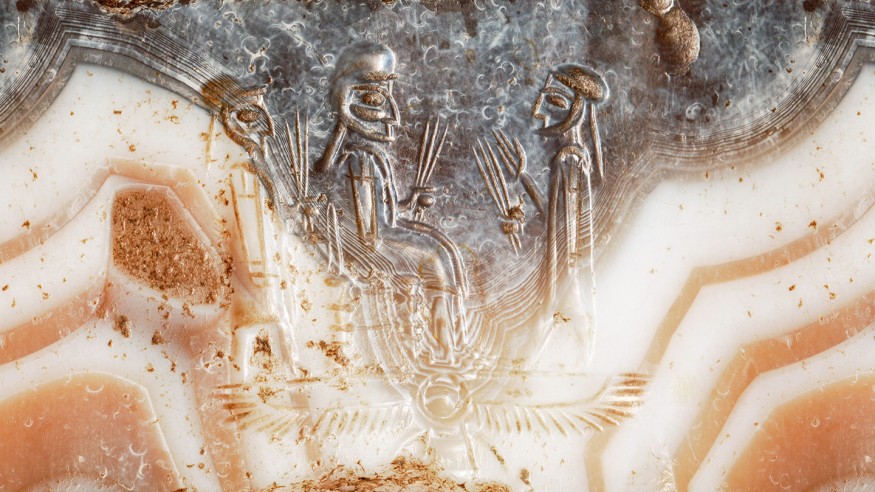
‘Miniature Masterpieces’
Researcher to Discuss, Display Mesopotamian Cylinder Seal Art Feb. 25 at Ohio Wesleyan

DELAWARE, Ohio – In Ancient Mesopotamia, small stone cylinders were carved with intricate designs that could be rolled onto damp clay and other surfaces to create unique signatures. Over time, these cylinders became more and more elaborate, with artists creating “miniature masterpieces” under 2 inches tall.
Wayne T. Pitard has spent much of his career studying these impressions and will present “Miniature Masterpieces: The Art of the Ancient Mesopotamian Cylinder Seal” at 4 p.m. Feb. 25 at Ohio Wesleyan University. His free presentation will be held in the Benes Rooms of Hamilton-Williams Campus Center, 40 Rowland Ave., Delaware.
“The impression could be identified with the person responsible (or at least the office the person held) and thus served essentially as our signatures do today,” Pitard explains in a Biblical Archeology Society interview. “As time went on, the popularity of cylinder seals spread from governmental officials to the wider public. Seals came to be used to authenticate contracts, wills, adoptions, letters, etc. Over the millennia thousands of seals were produced.”
Pitard, Ph.D., is an emeritus professor of religion at the University of Illinois, Urbana-Champaign and former director of its Spurlock Museum, which works to “examine cultural diversity and shared humanity” through research that includes Ancient Mesopotamian cylinder seals. The seals were produced largely between 3400 and 400 B.C.
For his work, Pitard uses Hewlett-Packard Polynomial Texture Map (PTM) software and a digital camera to take high-resolution images produced by photographing an object multiple times with strobe lights that vary between images.
“The computer takes 32 images of the object with one of these lights shining each time,” Pitard says in an online video explaining his work, “and then the software merges those and creates a high-resolution picture.” Afterward, he is able to view the images using any configuration of the strobe lighting that he wishes to isolate different aspects of the objects.
Throughout his career, Pitard’s teaching has focused on religions of the Near East, with particular interest in the Ugaritic tablets and their impact on biblical studies. He is the author of “Ancient Damascus” and co-author of “The Ugaritic Baal Cycle,” and has written journal articles on topics as diverse as death and the afterlife in Canaanite and Israelite culture and temple-building in Northwest Semitic literature.
Pitard’s presentation is the annual lecture of Ohio Wesleyan’s Ancient, Medieval and Renaissance Studies Program, which helps students understand western culture through interdisciplinary studies of the history, literature, art, music, science, and religions that form the basis of western civilization. Learn more at www.owu.edu/amrs.
The event is co-sponsored by the Earl A. Russell Lecture Fund in the Department of Religion, the Department of Fine Arts, and the Middle Eastern Studies Program.
Founded in 1842, Ohio Wesleyan University is one of the nation’s premier liberal arts universities. Located in Delaware, Ohio, the private university offers more than 90 undergraduate majors and competes in 25 NCAA Division III varsity sports. Through Ohio Wesleyan’s signature OWU Connection program, students integrate knowledge across disciplines, build a diverse and global perspective, and apply their knowledge in real-world settings. Ohio Wesleyan is featured in the book “Colleges That Change Lives” and included in the U.S. News & World Report and Princeton Review “best colleges” lists. Learn more at www.owu.edu.

